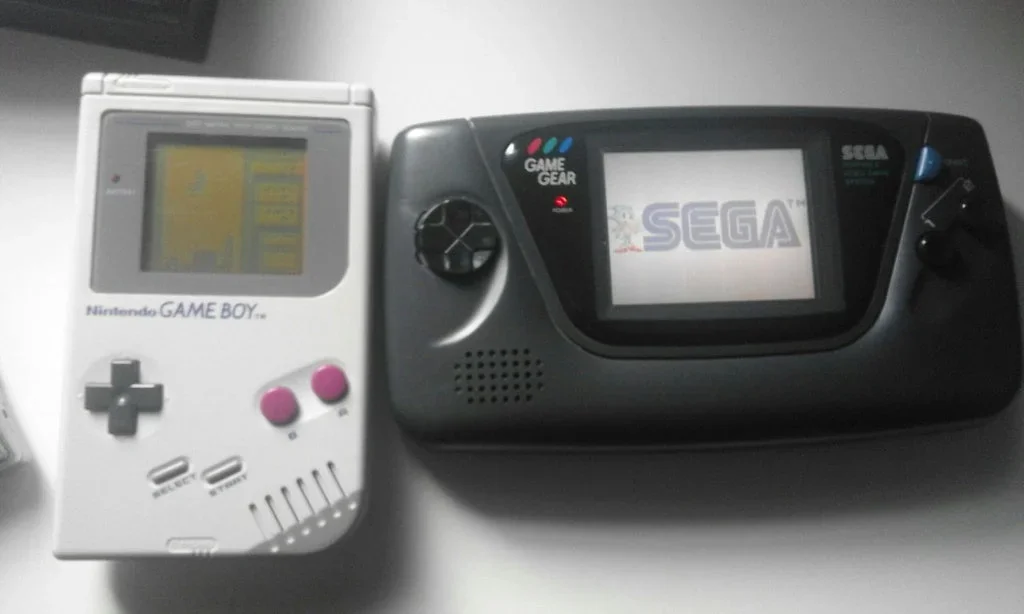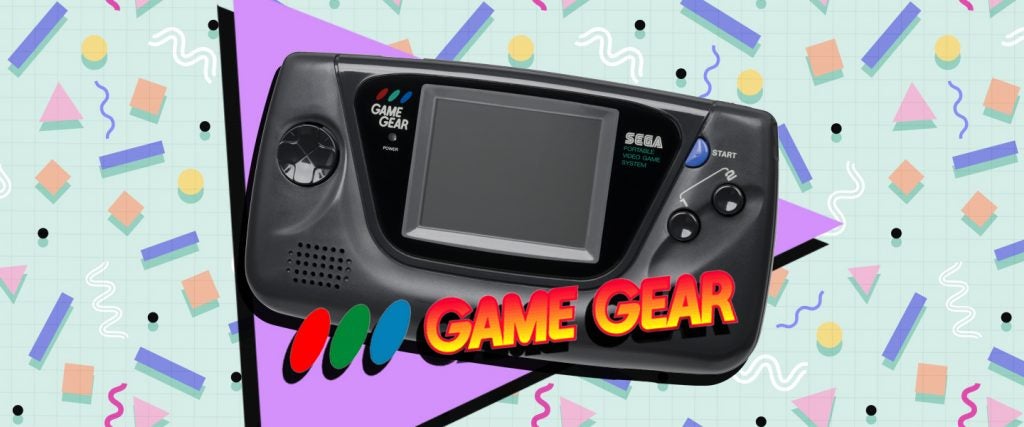2022 marks the 25th anniversary of the year that everything happened — 1997. It was an ear-biting, Pierce Brosnan-loving, comet-obsessed world, and we’re here to relive every minute of it. Twice a week over the next 12 months, we will take you back to the winter of sheep cloning and the summer of Con Air. Come for the Chumbawamba, and stay for the return of the Mack. See all of the stories here.
With full-color, 8-bit graphics and a backlit screen designed for late-night gaming, the Sega Game Gear allowed you to have the power of Sonic the Hedgehog — and a flurry of other heroes — right in your hands. It may not have been the most popular system of the day, but the kids who had a Sega Game Gear knew their system was vastly superior to that dull, green-tinted Nintendo Game Boy, which, even by the standards of the early 1990s, was archaic. Its brick-like weight and relative un-coolness didn’t matter — if you had one, you loved it.
Yet, by April 1997, Sega had canceled the Game Gear and removed it from the market, licking its wounds in the process. Despite having superior technology to the Game Boy, Sega’s handheld console had trailed behind Nintendo’s for six years, and after the Game Gear ceased production, Sega would never fully venture into the handheld market again. Not only that, but within a few years, Sega would pull out of creating their own consoles altogether, opting instead to make games for what was once their competition.
Both then and now, the Game Gear was seen as too big and heavy, with a dearth of games and an unquenchable appetite for batteries. The Game Gear’s discontinuation also coincided with a flurry of other issues with Sega, which furthers the idea that it somehow contributed to the company’s downfall. However, some video game historians — as well as some remaining Game Gear stans — feel that the Game Gear has been judged too harshly. Perhaps, then, it deserves a second look.
Rather than start with the Game Gear itself, it makes sense to rewind back to 1989 and the release of its nemesis, the Game Boy. Although the original Game Boy would likely be considered clunky by modern standards — especially when compared to a cell phone — it was considered comfortably portable in 1989, and relatively lightweight as well. It was also fairly simple technology, so Nintendo and other gaming companies made a ton of low-cost games for it. Plus at just $90, the Game Boy wasn’t all that expensive, and made for a perfect “big gift” for a kid at Christmas.
Children weren’t the only ones buying Game Boys, though. “Everybody knew what a Game Boy was — you had grandparents playing Game Boy,” explains Andrew Borman, the digital games curator at the Strong Museum of Play. He notes that Tetris — Game Boy’s top-selling game — was particularly successful across a wide range of ages. Within just a few weeks of its release, the Game Boy had already sold a million units and, with a monstrous library of games, there’d be no slowing it down for almost a decade. “It’s hard to overstate just how big of a success the Game Boy was,” says Borman.
The only problem with Game Boy was that the games kind of looked like shit. Not only were they all technically black and white, but the screen for the original Game Boy was an ugly pea soup color, and the sole adjustment the system allowed for was a tint scroller that made the greenish shades of gray darker or lighter.
Thus, image quality would be Game Gear’s biggest area of opportunity when it hit North American markets in April 1991. It was in full color, and many of its games were direct ports of games from their Master System (which predated the Genesis). In other words, as Borman puts it, “You had console-quality games on the Game Gear.” The system was also backlit, like a cell phone is, which means it could be played in the dark, unlike the Game Boy (unless you had the Light Boy add-on).
When it came to image quality then, Game Gear and Game Boy weren’t even in the same league. In fact, they weren’t even meant to be direct competitors. “When Sega released the Game Gear, they did it to compete more so with the more high-end handheld gaming systems the Atari Lynx and the TurboExpress,” explains Kenneth Horowitz, author of Playing at the Next Level: A History of American Sega Games. Both of these systems, though largely forgotten today, were full-color portable gaming systems that came out in between the Game Boy and the Game Gear.
The Lynx retailed for $180 while the TurboExpress went for $250, so when Game Gear hit the market for $150, it was intentionally undercutting them by a significant amount, even if it was still $60 more than a Game Boy. Sega would also, to some degree, get what it wanted out of the system, in that it quickly superseded both of those high-end systems and became a firm second place in the handheld arena. According to Sega Retro, in North America, the Game Gear sold a respectable four million units in its first two years on the market. And through interviews with Sega executives for his various books about Sega’s history, Horowitz explains that Sega was fairly pleased with Game Gear’s sales for the system, and that the launch went moderately well. “The only problem was that Game Boy ended up eating everybody’s lunch,” he adds.
Whether they wanted it to or not, Game Gear would end up competing with Game Boy, and — aside from image quality — it would fail at pretty much every turn. For one thing, Borman notes how important it was that the Game Boy had hit the market almost two years before Game Gear. “Getting those early adopters is extremely important,” he says. “A lot of people latch onto one system, and they’ll likely stay with that until they get out of video games altogether, or until they get to the next big system which is a major upgrade.”

The Game Gear was also a lot less portable than the Game Boy. For one thing, it was measurably bigger and heavier, but it also required a lot more batteries. Whereas the original Game Boy took four AA batteries that might last for 15 hours, the Game Gear took six AA batteries and lasted only from three to five hours. This was easily Game Gear’s biggest weakness. After all, half the reason why parents bought their kids portable systems was to shut them up while they were traveling, and if your Game Gear died a couple of hours into a long road trip, that kind of defeated its purpose. “Parents didn’t care about graphics or that Game Gear was color,” Horowitz explains. “Parents only looked at the initial cost, battery life and which system had more games.”
On the latter count, the Game Gear would eventually amass nearly 400 games in its six-year run, but that was nothing compared to the Game Boy, which would end up with well over a thousand games. Nintendo’s head start was part of the reason for this, but there were other factors as well. According to Horowitz, Nintendo had a number of cutthroat business practices that gave them an edge, including pulling from retailers that gave too much shelf space to the competition, or showing favoritism toward game publishers that didn’t make games for other systems. In time, Nintendo would be sued for this behavior, and they eventually backed off, but for Game Gear, the damage was largely done.
Still, despite its many shortcomings, the Game Gear did have its loyalists, and a number of classics were produced for the system. There’s a lot of love by retro gamers for Sonic Triple Trouble, Tails Adventure, Shinobi and its X-Men game, all of which were exclusives to that system. It also enjoyed success with titles like Sonic the Hedgehog, which had been previously released for the Sega Master System. But there were no games that exploded in a major way. Meanwhile, Nintendo managed to churn out hits on an annual basis. Case in point: In 1996, the first two Pokémon games became a huge hit on the Game Boy.
Moreover, Sega made no effort to fix what was so clearly wrong with Game Gear’s size and battery life. By contrast, in 1996, the Game Boy released the Game Boy Pocket, which was a slimmed down Game Boy that ran on just two AAA batteries.
By 1996, it was clear that Game Gear was nearing its end, as just 10 games for the system were released all year. It also seemed that Sega was uninterested in the future of handhelds, as they’d failed to market 1995’s Sega Nomad — a portable Sega Genesis — in any significant way.

So it was of no surprise when, in the spring of 1997, Sega ceased production of the Game Gear. All told, the system sold almost 11 million units worldwide. While that was tiny compared to the nearly 120 million units the Game Boy sold, it wasn’t bad. In fact, Horowitz says that the Game Gear’s abandonment had little to do with the Game Gear at all. It was economic problems at Sega that did it in, not deficiencies with the device itself.
Despite the fact that Sega had done extremely well with the Sega Genesis, they made one misstep after another after that. First, there was the ill-fated Sega CD and Sega 32X, both of which were add-on systems that plugged into the Sega Genesis. Neither were breakout successes, in large part because they required you to buy another expensive add-on to play their own exclusive games. Then there was the abysmal launch of the Sega Saturn in 1994 (Japan) and 1995 (North America). In order to beat the first PlayStation system to market, Sega rushed the Saturn’s release so much that it barely had any games when it arrived in stores. The Sega Dreamcast in 1998/1999 fared a little better, but not significantly so. “The damage to Sega’s reputation had already been done,” Borman says.
As for the Game Gear, it was already naturally fading by 1995, but when it became clear to publishers and the public that it was no longer a priority for Sega, they lost interest as well. “I don’t think the Game Gear was discontinued because Sega realized that they’d lost to Nintendo. It was because Sega was having economic problems and they were cutting fat,” says Horowitz. If anything, their bungling of the Saturn was probably the biggest blunder, and the Game Gear just paid the price for it.
After Sega lost “The Console Wars,” they got back to what they do best, making games. “People forget that Sega wasn’t a console company,” says Horowitz. “They began as a coin-op arcade company, then they dabbled in consoles in the 1980s and 1990s, then they got out of it and went back to coin-op.”
Which, frankly, when it comes to handheld consoles, is no big loss. While some retro gamers might still have some love for the brick-like Game Gear and the rush of nostalgia it brings them when they turn on its tiny full-color screen, it’s probably for the best that Sega isn’t still cranking out systems that burn batteries faster than Sonic can down a chili dog.


